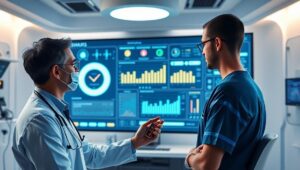Remote Patient Monitoring: A 2026 Outlook
Remote Patient Monitoring (RPM) is poised to revolutionize healthcare by 2026, driven by advancements in wearable technology and implantable devices. This article explores the current state of RPM, future trends, and potential impact on patient care.
Current State of RPM
RPM involves using technology to monitor patients’ health data from a distance. This data is then transmitted to healthcare providers for analysis and intervention. Common devices used in RPM include:
- Wearable Sensors: Smartwatches, fitness trackers, and specialized sensors that monitor vital signs, activity levels, and sleep patterns.
- Implantable Devices: Pacemakers, glucose monitors, and other devices that are surgically implanted to continuously monitor specific health conditions.
- Mobile Apps: Applications that collect and transmit data from wearable and implantable devices, as well as patient-reported outcomes.
Future Trends in RPM (2026)
By 2026, RPM is expected to evolve significantly, driven by several key trends:
-
Advanced Sensor Technology: Next-generation sensors will be smaller, more accurate, and capable of monitoring a wider range of health parameters. Expect integration of biosensors that can detect biomarkers in sweat or interstitial fluid.
-
AI-Powered Analytics: Artificial intelligence (AI) will play a crucial role in analyzing the vast amounts of data generated by RPM devices. AI algorithms will identify patterns, predict health risks, and personalize treatment plans.
-
5G Connectivity: The widespread adoption of 5G networks will enable faster, more reliable data transmission, which is essential for real-time monitoring and timely intervention.
-
Integration with Electronic Health Records (EHRs): Seamless integration of RPM data with EHRs will provide healthcare providers with a comprehensive view of patient health, facilitating better-informed decision-making.
-
Increased Focus on Cybersecurity: As RPM becomes more prevalent, ensuring the security and privacy of patient data will be paramount. Expect robust security measures to protect against cyber threats and data breaches.
Impact on Patient Care
The widespread adoption of RPM has the potential to transform patient care in several ways:
- Improved Outcomes: Continuous monitoring and early detection of health issues can lead to more timely interventions and better patient outcomes.
- Reduced Healthcare Costs: By preventing hospitalizations and emergency room visits, RPM can help reduce overall healthcare costs.
- Enhanced Patient Engagement: RPM empowers patients to take a more active role in managing their health, leading to increased adherence to treatment plans.
- Greater Access to Care: RPM can extend healthcare access to remote and underserved populations, improving health equity.
Challenges and Considerations
Despite its potential benefits, the widespread adoption of RPM faces several challenges:
- Data Overload: Healthcare providers may struggle to manage the large volume of data generated by RPM devices.
- Reimbursement Issues: Clear reimbursement policies are needed to incentivize the adoption of RPM by healthcare providers.
- Regulatory Framework: A clear regulatory framework is needed to ensure the safety and efficacy of RPM devices and services.
Conclusion
Remote Patient Monitoring is poised to revolutionize healthcare in the coming years. By 2026, advancements in wearable technology, AI, and connectivity will enable more effective, efficient, and personalized patient care. Overcoming the challenges related to data management, reimbursement, and regulation will be crucial to realizing the full potential of RPM.




